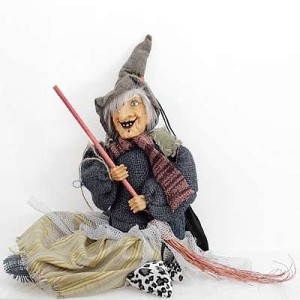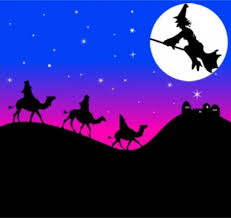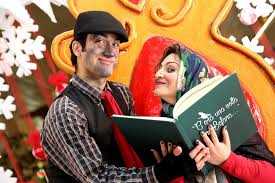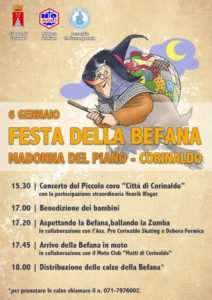 All around Italy, i ragazzi, the kiddos, have hung their calze, stockings, by il camino, the chimney, with care, in hopes that la Befana soon will be there.
All around Italy, i ragazzi, the kiddos, have hung their calze, stockings, by il camino, the chimney, with care, in hopes that la Befana soon will be there.
i bravi, the good ones, will get caramelle, candies, and little regali, gifts, while i cattivi, the bad ones will get carbone, coal.
 While Babbo Natale, Santa Claus, comes during the night of December 24/25, la Befana arrives during the night of January 6/7, coinciding with l’Epifania, Epiphany.
While Babbo Natale, Santa Claus, comes during the night of December 24/25, la Befana arrives during the night of January 6/7, coinciding with l’Epifania, Epiphany.
There are other notable similarities and differences between Santa and la Befana.
 Just like Babbo Natale, la Befana travels through the air. In place of a sleigh with flying reindeer, la Befana flies on a scopa, a broomstick, from house to house where there are bambini, children, entering by way of il camino.
Just like Babbo Natale, la Befana travels through the air. In place of a sleigh with flying reindeer, la Befana flies on a scopa, a broomstick, from house to house where there are bambini, children, entering by way of il camino.
Where Babbo Natale is rotund, merry, white-bearded and dressed in red and white, la Befana is depicted as a smiling, grandmotherly witch, wearing tattered clothing and covered in soot astride a broomstick.
Just like Santa Claus, la Befana’s origins are nebulous, mainly the stuff of folklore, with many variations.
 The most common story I encounter is that la Befana lived along the route the Magi took to Bettlemme, Bethlehem. In this version, they stopped at her house seeking food and shelter, but she wasn’t feeling sociable and sent them away.
The most common story I encounter is that la Befana lived along the route the Magi took to Bettlemme, Bethlehem. In this version, they stopped at her house seeking food and shelter, but she wasn’t feeling sociable and sent them away.
Later, la Befana had a change of heart and set out to find the Magi to accompany them to find the Christ Child. But by then, she was too late to catch up, and she never found the three kings or il Gesù Bambino, the baby Jesus.
So, as the story goes, to this day, at this time of year, she still travels the world, leaving gifts for every child, lest they be il Gesù Bambino.
January 6, the Epiphany, marks the official end of the Italian Christmas holiday season. It is also said that la Befana takes away the old year, and i dolci, sweets, and regali she brings symbolize seeds to grow in the new year.
Many cities and towns hold special events and parties dedicated to celebrating la festa dell’Epifania/la Befana, Epiphany holiday. People play bingo and cards, and gather outdoors in le piazze, the squares, for festivities, including music, processions, live presepi, nativity scenes, mercatini, open-air markets, and live appearances by la Befana.
And while it’s mainly a celebration for the kiddos, you’ll find adults getting in on the action, too, dressing up and parading around as la Befana.
Feeling festive? Perhaps you want to get into the act, too… You could wish people “Buona Befana!,” a popular greeting on January 6 in Italy.
 This could be a great time to adopt a fun new tradition, with kids, family or friends. All you need is una calza, a stocking!
This could be a great time to adopt a fun new tradition, with kids, family or friends. All you need is una calza, a stocking!
If you want to watch a fun movie on the theme, check out “The Legend of the Christmas Witch,” on Prime Video. You can choose to watch it in English or original Italian, with or without English subtitles.
Buona Befana, and hope she brings you caramelle!
Have you heard of la Befana before? Do you have any special observances for Epiphany? Leave a comment!
Have fun practicing the Italian words in this story on Quizlet!! Click here to access the Quizlet Christmas Round-up list, and use the password NATALE.




We have celebrated L’Epifania for years. It started when our kids were little and were overwhelmed by opening all their Christmas gifts (a good problem, I realize–they were spoiled by the grandparents and aunties!) so we started having them save a few presents to open on January 6th. Then, when we realized it was nuts trying to get together with all our friends prior to the 25th, we started “training” our American friends so they knew what Epiphany was and why we were still having a Christmas party in January. We would bake a cake with the three colors of Epiphany (yellow, purple and green–just like Mardi Gras) and whoever found the chocolate coin got to be the king or queen and won a crown and a bag of chocolate coins. Fun times!
Ciao Paula, che bella tradizione! What a beautiful Epifania-inspired tradition you created! I love that you brought other friends into the mix as well. I have been to a French Kings party, where there was a small plastic baby baked into the cake, and the guest who got it in their slice, would be the one to host the next party. Stammi bene amica, be well my friend & buon 2021!